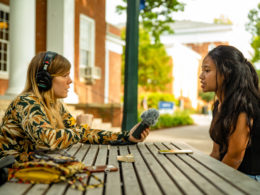A decade after the creation of Giving Tuesday, local nonprofits continue to rely on the eleemosynary-themed day as a means for boosting annual giving, even as some organizations profess fatigue in trying to create campaigns that stand out above the din of competition.
The brainchild of the 92nd Street Y and its Belfer Center for Innovation & Social Impact in 2012, Giving Tuesday began as a simple idea: encourage people to kick off the holiday season by donating to the charity of their choice. Since then, the day has become a giving juggernaut, an iconic date that today rivals its more profit-minded calendar neighbors, Black Friday and Cyber Monday.
Now an independent nonprofit of its own as of 2020, Giving Tuesday reported donations in 2021 totaling some $2.7 billion, more than the gross national product of Aruba.
By all accounts, Richmond-area nonprofits are riding Giving Tuesday’s wave of popularity, with many local organizations incorporating the day as part of its overall fundraising strategy.
“It’s one more touch point during the calendar year,” says Nell Nutaitis, vice president of development and communications at ChildSavers. “We do a pretty aggressive online campaign related to Giving Tuesday with lots of reminders leading up to the actual day, and if we didn’t, I think some donors would wonder where we were.”
The expectation to participate is one reason that Children’s Hospital Foundation continues to put an emphasis on Giving Tuesday.
“We take part in Giving Tuesday, not only as a day of philanthropic awareness, but because it’s a day that our donors expect to (and want to!) hear from us,” said Lauren Zaller Moore, foundation president and CEO.
CHF also leverages Giving Tuesday as a way to promote its annual Radiothon, which takes place the following Wednesday and Thursday. Those broadcasts air first-hand stories on the impact that donors’ gifts have had on the lives of children.
Similarly, the Virginia Home for Boys and Girls has found that seasoning its Giving Tuesday social media campaign with videos about the organization’s work creates more impact.
The emphasis on social media is similar to the approach at SOAR365, said Diana Miller, APR, vice president, marketing and communications, who credits the end-of-year timing of Giving Tuesday as one reason for its popularity.
“Many people make decisions about their charitable giving as we approach the end of the year, so Giving Tuesday allows us one more opportunity to remind our donors of the great work we do in our community,” Miller said.
But at VPM, the local PBS-NPR member station, there’s a sense that the end-of-year timing can complicate year-end fundraising efforts, or as with the station, membership drives.
“I’ve worked with three nonprofits since Giving Tuesday launched in 2012, and I think the concept behind an official launch to the giving season and a balance to the commercial spending the weekend following Thanksgiving is great,” said Jennifer Whiteside, director of membership.
But she warns, there’s a risk that time of the year often conflicts with other fundraising strategies already in place for calendar-year end: “We try not to confuse our audience with too many varying messages, so often Giving Tuesday feels a little additive.”
That warning rings true to CHF’s Moore.
“I personally struggle with Giving Tuesday in that I fear charitable organizations may fatigue the public,” she said. “I have many causes that are dear to my heart, and even I, as a leader of a charitable organization, get overwhelmed by the number of requests I see on Giving Tuesday. That said, I love that it is a beautiful reminder of the many deserving places where we can invest our philanthropy throughout the year.”
Alan Hutson, principal and managing partner at The Monument Group, a Richmond-based consultancy specializing in fundraising counsel to nonprofits, worries about the cacophony associated with Giving Tuesday.
“Giving Tuesday has become so ‘noisy’ with all of the nonprofits raising money on the same day,” Hutson said. “What we are seeing now is more nonprofits either encompassing Giving Tuesday into an overall strategy or just using Giving Tuesday as a way to reach out to a new giving demographic – for example, volunteers who have never given financially before.”
Toward that end, most organizations say that Giving Tuesday does not represent a large part of their annual income.
That’s the case at ChildSavers where the $60,000 raised through Giving Tuesday in 2021 was just over 2 percent of the nonprofit’s annual fundraising budget. Even so, 100 people responded to Giving Tuesday solicitations last year, which represents almost one-sixth of the total number of givers. Nutaitis sees Giving Tuesday as a means for attracting more longer-term donors and continuing to raise the visibility of ChildSavers in the community.
Last year, Richmond SPCA juiced the incentive for donating on Giving Tuesday. One of its donors agreed to triple the total number of Giving Tuesday donations (up to $7,000), an enticement that helped the organization raise just under $30,000 on the day. Richmond SPCA is considering a similar matching program for 2022.
There are also reasons to participate in Giving Tuesday beyond the financial incentives.
“Giving Tuesday doesn’t make up a large part of our donor income, but it’s a great way to increase awareness about us,” SOAR365’s Miller said. “Because Giving Tuesday is shared via social media, it exposes us to individuals who may not otherwise have heard of us and who might be interested in our mission. Every year, we have been able to reach someone new. Our approach is to take advantage of the fact that there’s an international day of giving that might encourage our current donors to make their end-of-year gift while also getting our name out in from of some prospects that may not know much about us.”
Giving Tuesday this year is November 29.










